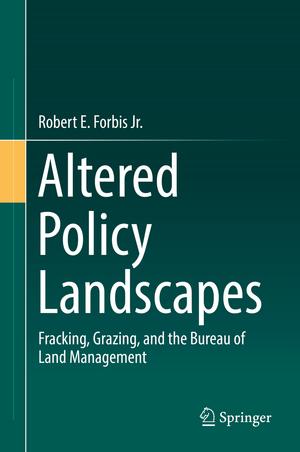Altered Policy Landscapes: Fracking, Grazing, and the Bureau of Land Management
Autor Robert E. Forbis Jr.en Limba Engleză Hardback – 21 feb 2019
Chapter 1 introduces readers to the case study at hand, and reviews literature on public land agencies and policies. Chapter 2 summarizes thelegal history of public land management by the federal government, and the conditions that caused the BLM to favor energy development over ranching in the mid-2000's. Chapter 3 details the role of the Executive Branch (Bush-Cheney administration) in affecting the BLM's domestic energy policies and resource allocation, and chapter 4 analyzes the role of subgovernments in affecting the BLM's motivations too. Chapters 5, 6 and 7 contain first-hand accounts from government officials, state petroleum associations, and ranching supported interest groups to explore the concept of subgovernment stakeholder domination in policymaking, and analyze the similarities and differences between different policy-making elites. Chapter 8 concludes the text by summarizing subgovernment theory, mapping the behaviors of subgovernment actors, and discussing the implications for future political appointees in the direction of land-management agencies like the BLM.
Preț: 564.96 lei
Preț vechi: 706.20 lei
-20% Nou
Puncte Express: 847
Preț estimativ în valută:
108.10€ • 112.87$ • 89.47£
108.10€ • 112.87$ • 89.47£
Carte disponibilă
Livrare economică 11-17 martie
Livrare express 01-07 martie pentru 59.75 lei
Preluare comenzi: 021 569.72.76
Specificații
ISBN-13: 9783030047733
ISBN-10: 3030047733
Pagini: 236
Ilustrații: XV, 172 p. 17 illus., 16 illus. in color.
Dimensiuni: 155 x 235 mm
Greutate: 0.49 kg
Ediția:1st ed. 2019
Editura: Springer International Publishing
Colecția Springer
Locul publicării:Cham, Switzerland
ISBN-10: 3030047733
Pagini: 236
Ilustrații: XV, 172 p. 17 illus., 16 illus. in color.
Dimensiuni: 155 x 235 mm
Greutate: 0.49 kg
Ediția:1st ed. 2019
Editura: Springer International Publishing
Colecția Springer
Locul publicării:Cham, Switzerland
Cuprins
Chapter 1. Introduction.- Chapter 2. Legal history.- Chapter 3. Executive branch.- Chapter 4. Subgovernments.- Chapter 5. Governance.- Chapter 6. Energy development.- Chapter 7. Ranching.- Chapter 8. Conclusion.
Notă biografică
Robert Forbis is an Assistant Professor of Political Science at Texas Tech University. He received his B.A. from the University of Texas at Austin (1990); and received his Masters of Public Administration (2004) and Ph.D. in Political Science from the University of Utah (2010). His research interests primarily concern Environmental Politics and Policy with emphasis on the policy nexus of environmental protection and energy development. His research specifically addresses political conflicts triggered by the hydraulic fracturing (fracking) energy resource development process. He teaches courses on Public Lands and Resource Management, Sustainability, Energy and Environmental Policy.
Textul de pe ultima copertă
This book documents the United States Bureau of Land Management's (BLM) shift from a rancher-dominated agency to an energy-dominated agency. This shift is analyzed by identifying the conditions under which the expansion of hydraulic fracturing (fracking) in the Rocky Mountain West triggered a political conflict between ranching and energy stakeholder groups. Through scrutiny of federal actions and policies implemented by the Executive Branch between 2004 and 2010, the book sheds light on the emphasis of domestic energy production during this time period, and how the traditional ranching and energy alliance was split by shifting policy interests. The book is meant for policy makers, natural resource agencies, and students and researchers engaged in political science, public administration, and natural resource management.
Chapter 1 introduces readers to the case study at hand, and reviews literature on public land agencies and policies. Chapter 2 summarizes thelegal history of public land management by the federal government, and the conditions that caused the BLM to favor energy development over ranching in the mid-2000's. Chapter 3 details the role of the Executive Branch (Bush-Cheney administration) in affecting the BLM's domestic energy policies and resource allocation, and chapter 4 analyzes the role of subgovernments in affecting the BLM's motivations too. Chapters 5, 6 and 7 contain first-hand accounts from government officials, state petroleum associations, and ranching supported interest groups to explore the concept of subgovernment stakeholder domination in policymaking, and analyze the similarities and differences between different policy-making elites. Chapter 8 concludes the text by summarizing subgovernment theory, mapping the behaviors of subgovernment actors, and discussing the implications for future political appointees in the direction of land-management agencies like the BLM.
Caracteristici
Documents the U.S. Bureau of Land Management's (BLM) shift from a rancher-dominated agency to an energy-dominated agency Identifies the conditions under which hydraulic fracturing (fracking) in the Rocky Mountain West triggered a political conflict between ranching and energy stakeholder groups Analyzes the BLM's current land-use policies in the context of a system dominated by energy development interests
